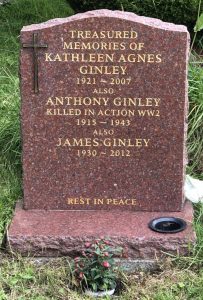Serjeant. 7th Battalion, Black Watch (Royal Highlanders)

Anthony Foy was killed in the Second World War. His real surname was Ginley but he was serving under his mother’s maiden name of Foy and his details on the Commonwealth War Graves Commission database state that he was buried in grave 9 of row A in plot 12 of Bergen-Op-Zoom War Cemetery in the Netherlands. He was aged 28 and died on the 30th of October 1944.
His name appears on the Ginley family grave in Utley Cemetery, Keighley.
As far as we can tell, he is not named on any war memorial in the local area under either surname of Ginley, or Foy.
Early life:
In 1911, James Ginley and his wife Mary were living with Mary’s parents, Anthony and Mary Foy, his wife’s seven siblings and his first child Winnie, in Craggera, Sallymount, a townland north east of Attymass in County Mayo, Eire.
Anthony Ginley was born on 8 March 1916 in nearby Cartron, His birth was recorded on 12 May 1916.
He was the fourth child of James and Mary. At this time James was a farmer.
In 1928, together with his mother, father and by now seven sisters, he arrived in Keighley, West Yorkshire, a popular destination for Irish immigrants at that time.
Anthony’s family report that at the age of twelve, he went to work, initially for his father who had become a stonemason and later, like very many other Irish immigrants from the west of Ireland, in the agricultural fields of West and North Yorkshire.
Over the next few years the family lived in several houses around Keighley town centre and in 1938 Anthony was living with his sister Winnie, who in January 1937 had married William Procter, at 48 Cherry Street.
In 1940 Anthony had moved and was living, presumably as a lodger, at 103 Bradford Street, Keighley.
War service:
In later years Anthony’s youngest sister, Maggie, spoke of him visiting their home with his fiercely loyal and intensively caring and protective attitude towards his family.
War had broken out but Anthony, with his vivid red hair, Irish accent and Irish nationalist pride was reluctant to join an English regiment and to avoid being conscripted he changed his surname to that of his mothers maiden name and enlisted as Private 2764499 Foy in the Black Watch – the Royal Highland Regiment, 7th Battalion. He soon rose through the ranks to become the Regiment’s Physical Training Instructor and eventually Acting Sergeant Major Foy.
Anthony fought under General Montgomery at El Alamein in 1943 as part of the 51st Highland Division, followed by service through North Africa into Tripoli via Mareth and Wadi Akarit. From here Anthony fought through Europe specifically in Italy, France, Germany and Holland. His battalion used their skills in amphibious landings to land in Sicily during operation Husky. After successfully landing on the Italian mainland the battalion returned to Britain to prepare for D Day.
On the afternoon of 7 June 1944 they landed in Normandy as a second echelon division to support and fill in behind the first wave. After suffering many casualties in the Bois de Bavent and after the fall of Caen on 11 July the Division was engaged in the push to close the Falaise Gap and through Le Havre and Dunkirk. In late September 1944, the 51st Highland Division moved East through France into Belgium and eventually towards Antwerp.
Together with the 7th Armoured, the 15th Scottish, the 33rd Armoured and the 53rd Welsh Divisions, they combined to form the 12th Corps tasked with clearing the Germans from south of the river Mass and on 23 October 1944 ‘Operation Colin’ commenced. Anthony’s war ended on 30th October, when he was aged 28. It is not known exactly where he died but it is believed that it was probably in the town of Sprang.
Sergeant Anthony Foy was buried at Waspik temporary burial ground shortly after his death. On the 13th of May 1946, his grave along with several other war graves was exhumed and reinterred at Bergen-Op-Zoom war cemetery in the Netherlands, a distance of thirty five miles to the South West of Waspik and about twenty miles North of Antwerp.
Information sources:
Commonwealth War Graves Commission.
Utley Cemetery.
Grave photo courtesy of Paul Skinner.
![]()
